Marus was a Palestinian village in Upper Galilee, 7 km northeast of Safad. In the Roman and medieval period it had Jewish population, and by the 16th century it became entirely Muslim. After a period of desertion, it was resettled by Algerian Arabs. It was depopulated in 1948 during the Operation Hiram by the Israeli attacking brigade Sheva' Brigade.

Tel Rehov or Tell es-Sarem, is an archaeological site in the Bet She'an Valley, a segment of the Jordan Valley, Israel, approximately 5 kilometres (3 mi) south of Beit She'an and 3 kilometres (2 mi) west of the Jordan River. It was occupied in the Bronze Age and Iron Age.
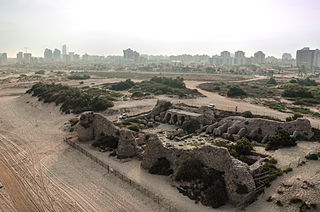
Ashdod-Yam or Azotus Paralios is an archaeological site on the Mediterranean coast of Israel. It is located in the southern part of the modern city of Ashdod, and about 5 kilometres northwest of the ancient site of Tel Ashdod, where ancient Ashdod stood in the time of the Philistines. Ashdod-Yam and its inland counterpart, Ashdod or Azotus Mesogaios, were for most of their history two closely connected but distinct entities. Much of the surrounding environ is covered by sand dunes and remains unexplored.

Kissufim is a kibbutz in the northwestern Negev desert in Israel. Located adjacent to the Gaza Strip at an altitude of 92 meters above sea level, it falls under the jurisdiction of Eshkol Regional Council. In 2022 it had a population of 294.
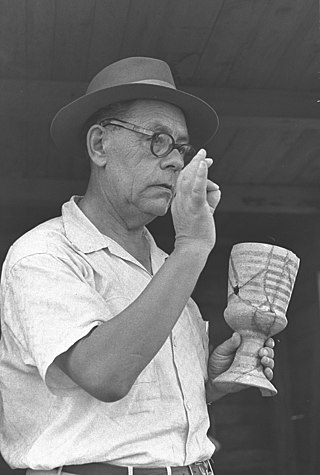
Eleazar Lipa Sukenik was an Israeli archaeologist and professor at the Hebrew University of Jerusalem. He is best known for helping establish the Department of Archaeology at the Hebrew University and being one of the first academics to recognise the age and importance of the Dead Sea Scrolls. He also oversaw the uncovering of the Third Wall of ancient Jerusalem. He also was the director of the Museum of Jewish Antiquities at the Hebrew University.

The Madaba Map, also known as the Madaba Mosaic Map, is part of a floor mosaic in the early Byzantine church of Saint George in Madaba, Jordan.

Nessana, Modern Hebrew name Nizzana, also spelled Nitzana, is an ancient Nabataean city located in the southwest Negev desert in Israel close to the Egyptian border. It started by being a caravan station on the ancient Incense Road, protecting a western branch of the road which allowed access to Egypt to the west via the Sinai, and to Beersheba, Hebron and Jerusalem to the northeast. It was first used by Nabataean merchants, and later also by Christian pilgrims.

Fiq was a Syrian town in the Golan Heights that administratively belonged to Quneitra Governorate. It sat at an altitude of 349 meters (1,145 ft) and had a population of 2,800 in 1967. It was the administrative center of the Fiq District, the southern district of the Golan. Fiq was evacuated during and after the Six-Day War in June 1967. The Israeli settlement of Kibbutz Afik was built close by.

Ehud Netzer was an Israeli architect, archaeologist and educator, known for his extensive excavations at Herodium, where in 2007 he found the tomb of Herod the Great; and the discovery of a structure defined by Netzer as a synagogue, which if true would be the oldest one ever found.
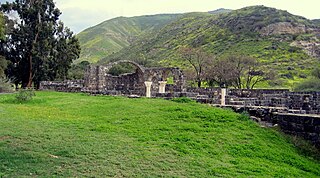
Kursi is an archaeological site in the Golan Heights containing the ruins of a Byzantine monastery and identified by tradition as the site of Jesus' "Miracle of the Swine". Part of the archaeological site is now an Israeli national park. Kursi takes its name from the Talmudic site. A marble slab with Aramaic text discovered in December 2015 seems to indicate that the settlement had, as of c. 500 CE, a Jewish or Judeo-Christian population.

Early Byzantine mosaics in the Middle East are a group of Christian mosaics created between the 4th and the 8th centuries in ancient Syria, Palestine and Egypt when the area belonged to the Byzantine Empire. The eastern provinces of the Eastern Roman Empire and its continuation, the Byzantine Empire, inherited a strong artistic tradition from pagan Late Antiquity. The tradition of making mosaics was carried on in the Umayyad era until the end of the 8th century. The great majority of these works of art were later destroyed but archeological excavations unearthed many surviving examples.
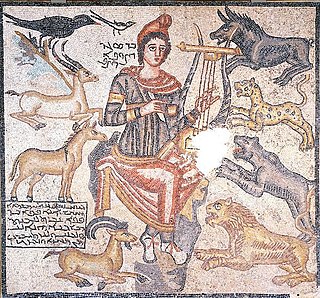
Orpheus mosaics are found throughout the Roman Empire, normally in large Roman villas. The scene normally shown is Orpheus playing his lyre, and attracting birds and animals of many species to gather around him. Orpheus was a popular subject in classical art, and was also used in Early Christian art as a symbol for Christ.

Umm el-Qanatir, also spelled Umm el-Kanatir, also known as Ein Keshatot, is an archaeological site on the Golan Heights, whose main phase is dated to the mid-5th–8th centuries. Excavations have revealed a Roman-period settlement, first inhabited by pagans and later by Jews, who left behind the ruins of an exquisite synagogue when they abandoned the town after it being destroyed by the catastrophic 749 earthquake. The site is located 10 kilometres east of the Dead Sea Transform, one kilometre southwest of Natur.
The Synagogue in the Agora of Athens is an ancient synagogue located in the Ancient Agora of Athens.

Tzippori Synagogue is an ancient synagogue discovered in Sepphoris, a Roman-era Jewish city in the Galilee, now an archaeological site and a national park in Israel.
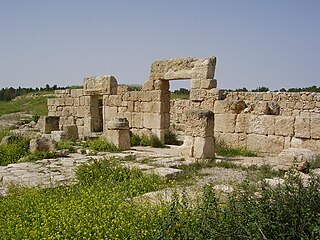
Anim Synagogue, a 25 km (16 mi) drive northwest of Arad, was an ancient synagogue in use during the 4th–7th centuries CE. The site is recognized as a National Heritage Site of Israel. It is located in the Yatir Forest, immediately south of the Green Line, in Israel.
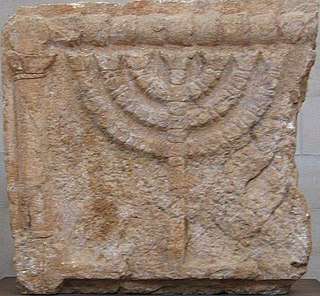
Ancient synagogues in Palestine refers to synagogues and their remains in the Palestine region, built by the Jewish and Samaritan communities from the time of the Hasmonean dynasty during the Late Hellenistic period, to the Late Byzantine period.

Huqoq or Hukkok was an ancient Jewish village, located 12.5 km north of Tiberias. The area had been settled since ancient times and is mentioned in the Book of Joshua. The Palestinian village of Yaquq later stood at Huqoq's location, and a fort named Hukok was built near the site on 11 July 1945, later followed by a kibbutz.
Maiuma is one of the names of the main ancient port of Gaza, at times functioning as a separate city; the other ancient port of Gaza was Anthedon. Its remains are situated at present-day Rimal near Gaza City in the Gaza Strip.

Horvat Maon/Horvat Ma'on, Arabic: Khirbet Ma'in or Tell Máîn, is an archaeological site in the Hebron Hills, West Bank, rising 863 metres (2,831 ft) above sea level, where the remains of the ancient town of Ma'on have been excavated. The town, now a ruin, is mentioned in the Book of Joshua and the Books of Samuel. It still had a Jewish population during the Roman and Byzantine periods, and a synagogue was discovered there. The site is located about 6 kilometres (3.7 mi) southeast of Yatta.
















